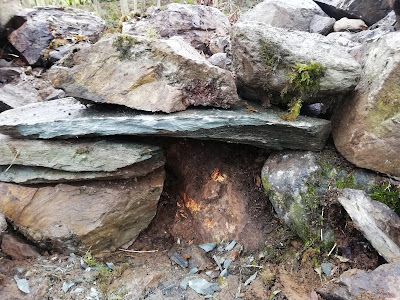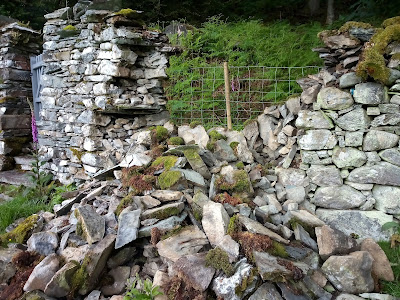NETTED CARPET MOTH SURVEY... EAST WINDERMERE.
In early September the annual survey for the rare netted carpet moth took place in the Lake District. The moth, in its larval stage, (caterpillar) depends entirely on nationally scarce annual touch-me-not balsam plants... its only food source.
The survey was led by Dr. Paul Hatcher of Reading University and John Hooson, Wildlife Adviser for The National Trust. The fact that they have led these annual surveys since 1990 is a testament to their dedication.
One day was spent at the East Windermere sites including National Trust St. Catherine's.
A splendid view of a touch-me-not stand at St. Catherine's through the open door of the staff toilet!..mid August. Over 100 caterpillars were recorded on these plants which is a tremendous result as this is not one of the larger sites.
Volunteers and colleagues from South Lakes National Trust were of great assistance in the survey work.
Volunteers can be seen here at another site...not National Trust owned... about half a mile from St. Catherine's. This site, once in decline, has improved through the removal of invasive species. 26 caterpillars were found here.
9 caterpillars were recorded at the Windermere School site; kind permission was granted by the school to survey the area.
Regrettably no caterpillars were found at the Millerground site.
However the numbers recorded elsewhere at East Windermere makes for encouraging news for future populations in this area..
A not fully grown caterpillar found under a touch-me-not leaf at Hodge Howe. By October the caterpillars will have pupated in the ground ready to emerge as adults in July.
Finally this is an image of the moth on touch-me-not balsam at St. Catherine's in late August.
******************************************************
ELECROFISHING SURVEY...TROUTBECK.
In late September two rangers from St. Catherine's met up with Jayne Wilkinson of South Cumbria Rivers Trust. An Electrofishing survey at Trout Beck...where it runs through National Trust farm land at Stonethwaite... had been scheduled.
Surveys take place between July and September throughout the catchment area.
To quote SCRT...
"A 50 metre stretch of river is chosen at each site and the following is recorded:
.AVERAGE WIDTH.
.DEPTH.
.RIPARIAN VEGETATION.
.PH
.TEMPERATURE.
.CONDUCTIVITY.
The voltage and pulse width of the electrofishing equipment is then adjusted according to the recommended settings for the respective water conductivity and fish species. This ensures the safety of the fish and the operators of the equipment.
The electrofishing operator is aided by two assistants who are then responsible for netting the fish and transferring them to holding tanks. After the 50 metre stretch has been completed the fish are then surveyed, recording fish species and length. In order to minimise stress, surveys are completed as quickly as possible and the fish are then returned along the length of the survey site.
Electofishing and its results give us a clearer picture of what species are in the river, numbers and fish health. It points us to issues and improvements that can be made to help fish migration, including: changes to barriers affecting migration, highlighting any pollution points and potential habitat improvement work. It's a great monitoring technique to ensure fish, river, and catchment health."

Jayne is working her way upstream, from one side to the other, using the electrofishing back pack equipment. Pete is about to net a fish. Trout and salmon were the fish to be surveyed.
After 6 metres a number of trout and salmon have been caught.
They are swiftly transferred to a large trug with an aeration system to keep them well oxygenated.
A juvenile salmon about to be measured. They have a more concave tail than trout and their upper jaw does not extend beyond the rear of the eye as it does with trout. They are also more streamlined in shape.
This is a trout. A positive id can be made here. The adipose fin is red. On the salmon it is not!
Jayne was happy with the results of the survey. 111 trout and 36 salmon in a 50 metre stretch indicates good fish and river health. As a rough guide only 60% of the fish in a 50 metre stretch of river will be caught for recording purposes.


















































